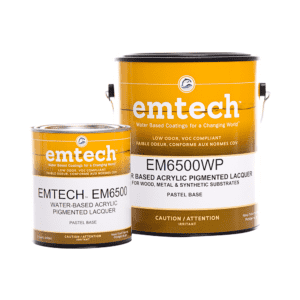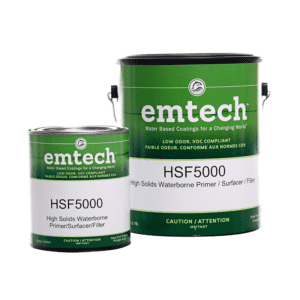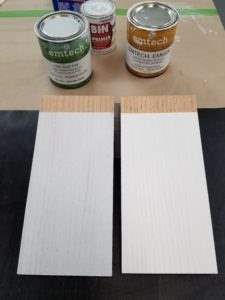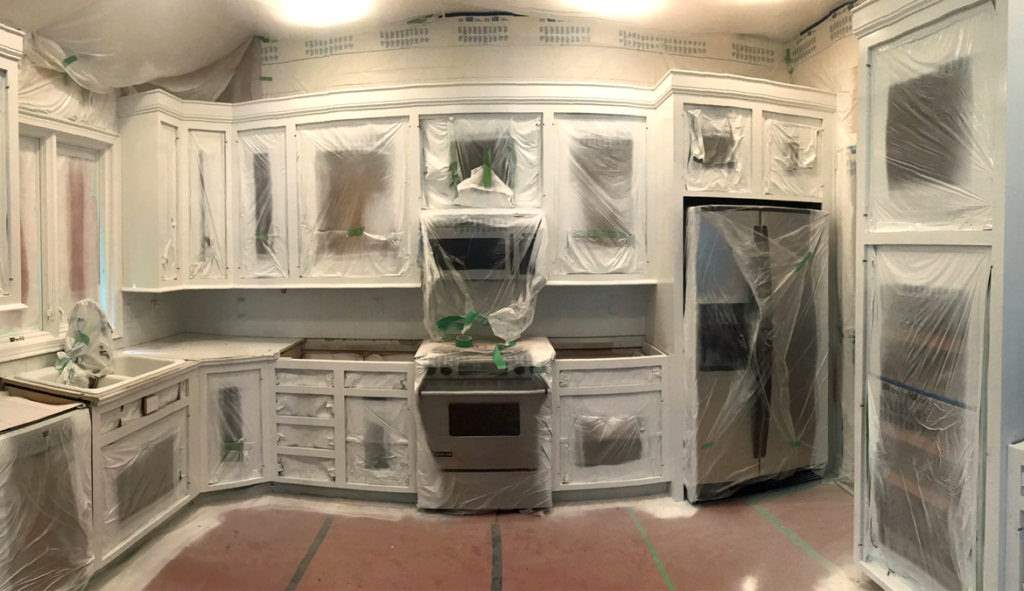Glad you are finding value in the wood finishing troubleshooting cheat sheet I’ve been sharing.
Big thanks to Blair L., Dan L., Barry, and Russ for their blog comments last week about, “Step 2: Stain and Topcoat Compatibility,” including…
“Keep the advice coming.”
“This is timely.”
And…
“Seriously helped me.”
I must admit, it feels great knowing I’m helping you with your projects and getting your finishes to come out the way you want.
So, today, let’s talk about Step 3: Use and Compatibility of Primers and Pigmented Topcoats.
I take a lot of calls from finishers who are confused about what type of primer to use underneath their pigmented topcoats, and the concern is understandable. Nobody wants to ruin a project by using incompatible products.
Here are four of the most frequent questions I field about primer and pigmented topcoat compatibility:
Question 1: What should I use to control tannin or sap stain from bleeding through when finishing with a water-based paint or pigmented lacquer?
Answer: Using a stain-blocking primer is critical to block tannin and sap stains from bleeding up through the pigmented finish.
I’m sure you have seen red oak create a brownish-red blush that works its way up to the surface of the freshly applied pigmented finish. White oak, pine, ash (and sometimes certain cuts of maple) are also prone to this.
The staining effect is caused by acids in the wood fiber reacting with the higher pH of the water-based coatings, and by the sap (pitch) reactivating when exposed to moisture.
It is important to use a low pH acrylic, or a shellac-based primer to help neutralize and block the tannin or sap from bleeding through.
See below for a few popular brands I confirmed work well with our Emtech EM6500 Pigmented Lacquer Series.
One thin, reduced coat of a pigmented primer rated for stain-blocking is OK to use in this situation.
The primer you use can be alcohol or water-based, but it is important to remember to thin the primer with its assigned thinner by upwards of 50% so “checking” or “mud-cracking” doesn’t happen when the pigmented lacquer is applied over it.
Question 2: How should I prime a prefinished surface (such as old kitchen cabinet doors) when I don’t know what type of finish was originally applied to them?
Answer: With any unknown, you first must ensure the surface is clean and free of contamination (see my previous cheat sheet notes about surface preparation).
Once clean, you should use one of the types of stain-blocking primers listed below to ensure adhesion to the unknown finish is complete.
Some of the most reliable brands and types of primers are:
- BIN® from Zinsser (their alcohol-based version is preferred)
- Block-Out® or STIX® from Insl-X (which is a water-based acrylic)
- Benjamin Moore Fresh Start® (available in alkyd and water-based formats)
These are reliable primers that will bond to a wide array of substrates and will also control the dreaded tannin/sap stain we discussed above.
Just ensure you follow the directions for the specific brand of primer you use.
Again, keep in mind, some primers need to be thinned to prevent mud-cracking and crazing when surfacers (see below) and pigmented lacquers are applied over them.
 Question 3: What do I use if I want to fill in the grain pattern to give the painted surface a flush, grain-free image?
Question 3: What do I use if I want to fill in the grain pattern to give the painted surface a flush, grain-free image?
Answer: This is where a special type of primer, called a surfacer, comes into play.
Surfacers are “ultra-high solids” versions of primers that help to fill and hide the negative grain on wood species such as birch, poplar and engineered surfaces such as MDF.
A good example is our Emtech HSF5000 Primer/Surfacer. HSF5000 will help prevent or completely stop the negative wood grain image from telegraphing, or “printing” back up through the pigmented topcoat.
Surfacers are used as the “Step-Two” in multi-step finishing processes to turn certain types of wood species into non-telegraphic substrates.
It is critical that you apply any surfacer coats in a thin wet film set – too heavy of a coat and you will be inviting mud-cracking somewhere down the finishing line.
Question 4: Can I use different types and brands of surfacers, primers and pigmented lacquers in my finishing schedule?
Answer: Yes, I have found the vast majority of water-based and solvent-based primers, surfacers and pigmented finishes will work just fine together as long as you follow the specific application procedures and dry-times of each part of the finishing equation.

Finally – and I will always repeat myself at this point – make sample panels and storyboards to confirm your finishing process and document your procedures before you take your final steps into the finishing room. Truer words…
I hope the above tips on getting primers and pigmented topcoats to “play nice” helps you achieve finish you’re looking for.
Stay tuned and watch your inbox for how to troubleshoot “Step 4: Drying and Curing.”
In the meantime, do you have any experiences, advice or questions about primers and pigmented topcoats compatibility? Please share your thoughts or read what others are saying in the comments section below.



It’s been a while since I’ve had to finish anything but I have a couple of projects coming up soon. Thanks for the refresher course Jeff.
Thank you, Rob. Good to hear from you!
-JW-
I’m painting the face frames of my existing kitchen cabinets and already purchased HSF5000 to prime them before applying EM6500. The original finish of the current face frames is in good shape. Do I need to apply a stain-blocking primer product before (or instead of?) applying the HSF5000?
Anthony — If the existing coating is in good shape and not worn-through to bare wood I do not see a reason to use a stain-blocking primer, however, by using a stain-blocking primer you will create a sound intermediate barrier coat between the old and the new finish. Keep in mind that the HSF5000 Primer is not stain-block rated but it does function as an intermediate barrier coat along with its grain filling functionality. I hope that this information is helpful.
-JW-
I’m building cabinets with maple plywood boxes with poplar face frames and door styles and rails, I have primed with Kilz original oil base primer. My home owners wants a white semigloss finish. I wanted to try some pigmented lacquer. Which emtec product should I use.
Charles — Thank you for your inquiry. Take a look at our EM6500 Pigmented Lacquer for use as your color coat. We can custom tint to match any Benjamin Moore, Sherwin-Williams or Farrow & Ball color found in their consumer color fandecks.
PS — EM6500 is only available in Satin sheen. If the customer specifies a semi-gloss you will have to apply a clear coat over the base color. I recommend our EM7000HBL or EM9300 Urethane for this sheen adjustment.
-JW-
Thanks for your expertise Jeff.
My question is regarding using 6500 over latex paint.
Refinishing raised panel doors that were brushed with a latex paint. Wondering if 6500 adheres to latex if sanded first then wiped down with the alcohol/water solution. I understand I need to test first but would like to know if that is even an option or should I just plan on a sealer first.
Thank you
Dan – Thank you for your inquiry and for your patience on waiting on my reply.
Yes, EM6500 Pigmented Lacquer will bond to properly cleaned and prepared paint, whether it is latex or oil-based in design.
Ensure that you clean the surface to remove any contamination with a mild pH all purpose cleaner, then rinse with a solution of water and denatured alcohol mix 1:1 to remove all residue. Once this is complete you can scuff sand the existing painted surface to remove defects using a fine sandpaper schedule (400-grit is acceptable), followed again by the water/dna wipe-down. From this point you can proceed to apply the EM6500.
Feel free to contact us directly if you have any further questions. :)
-JeffW-
Can you apply 6500 directly over lacquer finish after cleaning and sanding or is it better to use a bonding primer?
Clive – Yes, you can apply EM6500 Pigmented Lacquer over any well prepared painted/lacquered substrate. Thorough cleaning and a gentle scuff sanding, followed by a second cleaning with water and alcohol mixed 1:1 is all you need to do. EM6500 is self-sealing. Keep in mind that we do offer a primer, HSF5000 Primer/Surfacer, for special situations.
-JW-
Hi Jeff,
Just finished a kitchen cabinet refacing project. All new doors and drawer faces I built out of solid birch with Baltic birch panels. Sprayed 2 coats of your HSF5000 primer followed by 5 coats of the EM6500 in a light grey BM color. Almost perfect results! About 10% of the doors have an almost imperceptible alligator cracking and I’m at a loss as to what I might have done wrong. Any feedback would be appreciated
Chris –
Thank you for sharing the out come of your project with us.
The micro-checking you are seeing can be caused by several factors:
1. Rapid drying of the tinted EM6500 when applied at too thin wet mil thickness, coupled with over-atomization,
2. HSF5000 primer coats applied to heavy, i.e. over 4mils wet per coat,
3. Chemical reaction between the tinted EM6500 and a shellac-based primer used under the HSF5000 or EM6500.
There is an easy-fix to correct the problem and make the micro-check effect disappear:
1. Wipe the effected area with a solution of water and denatured alcohol mixed 1:1. Allow the solution to flash-off of the surface,
2. Fine sand the area with 320 or 400-grit aluminum oxide paper to level-sand the effect. Do not sand the effected EM6500 completely off – this is not necessary,
3. Wipe the sanded are again with water/alcohol solution,
4. Apply one, thin coat (2mils wet) of the tinted E6500 to match the unaffected area. Allow this coat to dry and observe to determine if the effect has melted into the fresh coat of EM6500.
Give me a call at 800.752.9922 to discuss the process in greater detail.
-JeffW-
Hello- is it possible to add more em6000 to a door that I had previously made, 2 years ago? It’s in the bathroom and I must not have applied enough coats the first time. Thank you.
Hi! Yes, there is no limit to the number of coats you can apply with EM6000 Production Lacquer. Please do some light scuff sanding with 400-600G or Fine sanding pad. Clean door with a solution of water and denatured alcohol mixed 1:1. After the cleaning solution dries off you can apply additional coats of EM6000. Thanks for posting.
-Seth Kline
Excellent read! I never knew how important it was to thin primers. I’ll definitely be more mindful of that in my next project. Thanks, Paul!